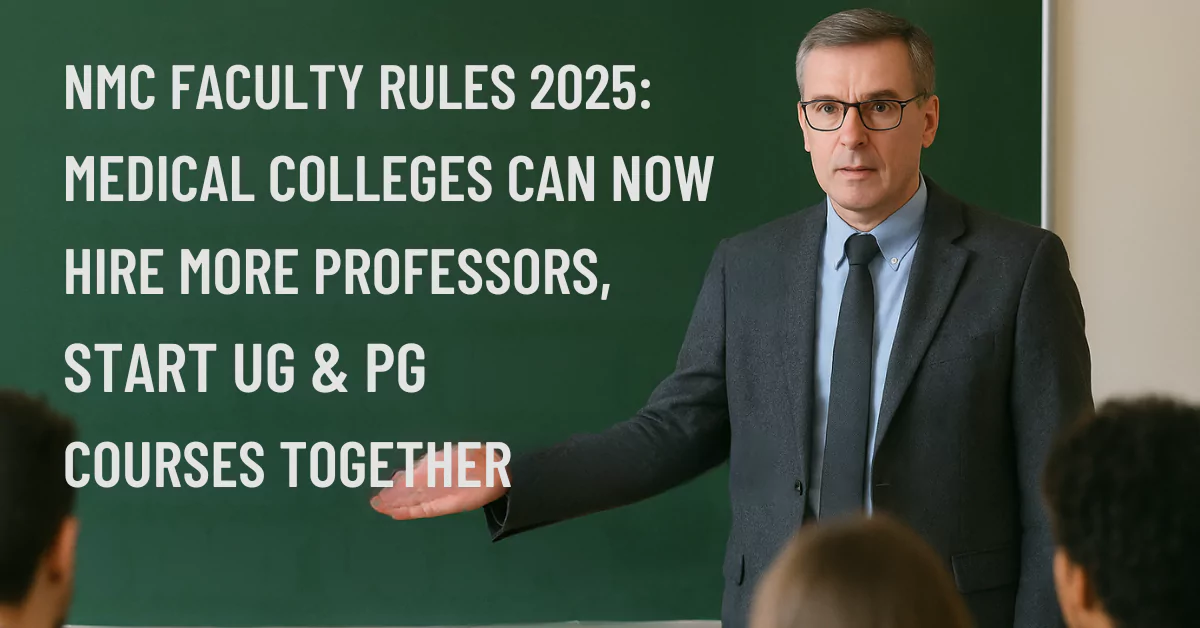NMC Faculty Regulations, 2025: The National Medical Commission (NMC) has officially notified the Medical Institutions (Qualifications of Faculty) Regulations, 2025, to address faculty shortages and increase India’s medical education capacity. Issued by the Post Graduate Medical Education Board (PGMEB), these new rules are expected to unlock thousands of new undergraduate and postgraduate medical seats by expanding the eligibility pool for medical faculty across the country.
The updated regulations are a strategic response to persistent bottlenecks in faculty availability, particularly in government institutions, and aim to ensure the optimal use of existing healthcare personnel in academic roles.
Key Highlights of the NMC Faculty Regulations, 2025
Enabling Government Hospitals to Become Teaching Institutions
- Non-teaching government hospitals with over 220 beds are now eligible to serve as teaching hospitals.
- Specialists with 10 years of experience can be appointed Associate Professors, while those with 2 years of experience may become Assistant Professors, without mandatory Senior Residency, provided they complete the Basic Course in Biomedical Research (BCBR) within two years.
Wider Recognition of Teaching Experience
- Senior Consultants with 3 years of teaching experience in NBEMS-recognized government institutions are now eligible for the post of Professor.
- Diploma-holding Specialists or Medical Officers with 6 years of relevant cumulative experience in NBEMS-affiliated institutions may be appointed as Assistant Professors.
- Time served in academic/regulatory roles, such as in NMC, state medical councils, universities, medical education departments, or government research organizations, can now be counted as teaching experience (up to 5 years).
Simultaneous Launch of UG and PG Courses
- New government medical colleges can now start MBBS and MD/MS courses simultaneously, which was earlier restricted.
- This change will significantly accelerate the production of doctors and teaching faculty, especially in underserved regions.
Relaxed Minimum Standards for PG Courses
- PG programs can now begin with just 2 faculty and 2 seats, compared to the earlier minimum of 3 faculty members and a Senior Resident.
- Bed requirements per unit for several specialties have been rationalized to make PG course initiation easier.
Expanded Entry Pathways and Subject-wise Flexibility
- MSc-PhD holders can now be appointed as faculty in the Microbiology and Pharmacology departments, extending the earlier eligibility that applied only to Anatomy, Physiology, and Biochemistry.
- Super specialty-qualified faculty working in broad specialty departments may now be formally designated as faculty in their corresponding super specialty programs.
Other Major Changes
- The upper age limit for appointment as Senior Residents in pre-clinical and para-clinical subjects has been increased to 50 years.
- Experience gained as Tutors or Demonstrators by candidates with PG degrees will now count toward Assistant Professor eligibility.
Addressing the Faculty Shortage Crisis
India has witnessed a dramatic expansion in the number of medical colleges in recent years. However, faculty shortages, especially in new and rural colleges, have hindered both UG and PG seat expansion. The 2025 regulations aim to:
- Widen the eligible faculty pool by recognizing the experience of medical officers, consultants, and administrative educators.
- Bridge the urban-rural divide by allowing non-teaching government hospitals to participate in medical education.
- Enhance the quality of education by enabling well-trained, experienced professionals to contribute without bureaucratic obstacles.
Read Also: AIIMS Faculty Shortage Crisis: Causes, Impact, and Solutions
Impact on Medical Education
The regulations are poised to:
- Increase thousands of new MBBS and PG seats in government colleges.
- Promote faculty recruitment from within public health systems.
- Ensure more equitable distribution of educational resources across the country.
- Accelerate super specialty education through better department utilization.
Also Read: Global Medical Education Crisis: Doctor Shortage, Limited Access & Student Migration
The NMC is expected to release detailed implementation guidelines, and state medical councils will likely issue notifications aligning with the central framework. Medical colleges, especially new and rural institutions, are expected to immediately benefit from the relaxed norms.
The Medical Institutions (Qualifications of Faculty) Regulations, 2025 marks a decisive step toward reform and expansion in India’s medical education sector. By redefining who can teach, where, and how, the NMC is not just addressing a shortage; it is reimagining the very structure of medical academia in India.

